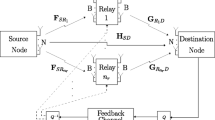Abstract
The integrated space and terrestrial networks which incorporate various satellite systems and ground networks could provide a wide variety of services and global seamless network access. The integrated network is composed of multiple heterogeneous nodes and sub-networks which requires intelligent and efficient physical layer transmission techniques to maintain high-speed links between these subsystems. As a traditional technology in satellite communications, relay could still work as an important part in these heterogeneous and complex networks. In this paper, two interference exploitation schemes, i.e., physical-layer network coding (PNC) and successive interference cancellation (SIC) which can efficiently increase data exchange rate for relay systems are studied, and an intelligent relaying scheme combining both the advantages of these two schemes is proposed. Simulation results show the proposed adaptive transmission scheme achieves a smoother sum-rate gain while being more robust to dynamic topologies.







Similar content being viewed by others
References
Pulliam J et al (2008) TSAT network architecture. In: 2008 IEEE military communication conference (MILCOM), pp 1–7
Vanelli-Coralli A et al (2009) The ISICOM architecture. In: 2009 international workshop on satellite and space communications (IWSSC)
H Yao L, Wang X, et al (2018) Wang the space-terrestrial integrated network (STIN): an overview. IEEE Comm Mag 56(9):178–185
Jia M, Liu X, Gu X, et al (2017) Joint cooperative spectrum sensing and channel selection optimization for satellite communication systems based on cognitive radio. Int J Sate Comm Net 35(2):139–150
Jia M, Gu X, Guo Q, et al (2016) Broadband hybrid satellite-terrestrial communication systems based on cognitive radio toward 5G. IEEE Wire Comm 23(6):96–106
GL Stuber JR, Barry SW, et al (2004) Mclaughlin broadband MIMO-OFDM wireless communications. Proc IEEE 92(2):271–294
Zhang S, Liew SC, Lam PP (2006) Hot topic physical-layer network coding. In: 2006 the 12th annual international conference on mobile computing and netwoking (MOBICOM)
Katti S, Rahul H, Hu W, et al (2008) XORS in the air: practical wireless network coding. IEEE/ACM Trans Net 16(3):497–510
Popovski P, Yomo H (2006) The anti-packets can increase the achievable throughput of a wireless multi-hop network. In: 2006 IEEE international conference on communications (ICC), pp 3885–3890
S Hu G, Bi YL, et al (2013) Guanl TDCS-based cognitive radio networks with multiuser interference avoidance. IEEE Trans Comm 61(12):4828–4835
Liew SC, Zhang S, Lu L (2011) Physical-layer network coding: tutorial, survey, and beyond. Physi Comm 6(1):4–42
B Li G, Wang PHJ, et al (2013) Chong performance of physical-layer network coding in asymmetric two-way relay channels. China Comm 10(10):65–73
Yang H, Li B, Liu B, Ma R (2018) Physical-layer network coding based multi-user cooperative relay transmission with multi-antennas in cognitive wireless networks. IEEE Access 6:40189–40197
Patel P, Holtzman J (1994) Analysis of a simple successive interference cancellation scheme in a DS/CDMA system. IEEE J Sel Areas Comm 12(5):796–807
Li B, Ding X, Yang H, et al (2018) Physical-layer network coding scheme over asymmetric Rayleigh fading two-way relay channels. Mobi Net App 23(1):80–85
Chen X, Wang H, Yang W, et al (2016) An optimal power allocation for two-way relay channel using physical-layer network coding. In: 2016 6th international conference on instrumentation and measurement, computer, communication and control, pp 486–491
Li B, Yang H, Liu G, Peng X (2018) The performance of physical-layer network coding in asymmetric Rayleigh fading two-way relay channels. Mobi Net App 23(2):301–307
Fan L, Lei X, Fan P, et al (2012) Outage probability analysis and power allocation for two-way relay networks with user selection and outdated channel state information. IEEE Comm Lett 16(5):638–641
Louie RHY, Li Y, Vucetic B (2010) Practical physical layer network coding for two-way relay channels: performance analysis and comparison. IEEE Trans Wire Comm 9(2):764–777
Sen S, Santhapuri N, Choudhury RR, et al (2010) Successive interference cancellation: a back-of-the-envelope perspective. In: 2010 9th ACM SIGCOMM workshop on hot topics in networks, pp 1–6
Hu S, Yu B, Qian C et al (2018) Non-orthogonal interleave-grid multiple access scheme for industrial internet-of-things in 5G network. IEEE Trans Ind Inf 14(12):5436–5446
Lu W, Gong W, Liu X, et al (2018) Collaborative energy and information transfer in green wireless sensor networks for smart cities. IEEE Trans Ind Inf 14(4):1585–1593
Liu X, Jia M, et al (2018) Multi-modal cooperative spectrum sensing based on dempster-shafer fusion in 5G-based cognitive radio. IEEE Access 6:199–208
Liu X, Jia M et al (2018) A novel multi-channel Internet of Things based on dynamic spectrum sharing in 5G communication. IEEE Int Things J 6(4):5962–5970
Acknowledgments
This work is supported in part by National Natural Science Foundation of China (No. 61671184, No. 61801144, and No. 61871348), Natural Science Foundation of Shandong Province (No. ZR2018PF001 and No. ZR2014FP016), the Foundation of Science and Technology on Communication Networks Key Laboratory, the Fundamental Research Funds for the Central Universities (No.HIT.NSRIF.2016100 and 201720) and the Scientific Research Foundation of Harbin Institute of Technology at Weihai (No.HIT(WH)201409 and No.HIT(WH)201410).
Author information
Authors and Affiliations
Corresponding author
Additional information
Publisher’s Note
Springer Nature remains neutral with regard to jurisdictional claims in published maps and institutional affiliations.
Rights and permissions
About this article
Cite this article
Wang, H., Wang, G., Li, B. et al. Exploiting Interference for Intelligent Relaying in Integrated Space and Terrestrial Networks Based on PNC and SIC. Mobile Netw Appl 24, 1947–1954 (2019). https://doi.org/10.1007/s11036-019-01336-1
Published:
Issue Date:
DOI: https://doi.org/10.1007/s11036-019-01336-1




